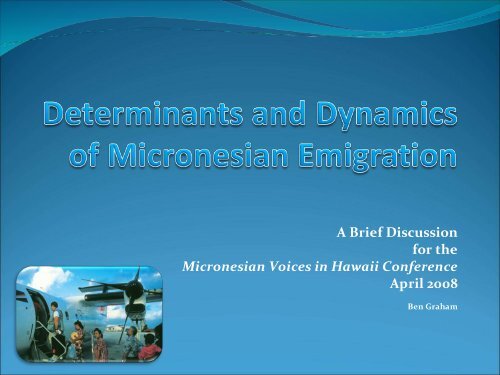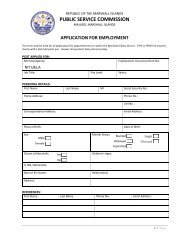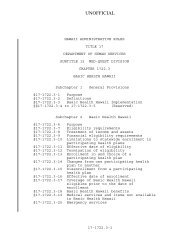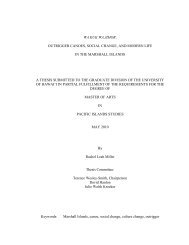Determinants and Dynamics of Micronesian Emigration
Determinants and Dynamics of Micronesian Emigration
Determinants and Dynamics of Micronesian Emigration
You also want an ePaper? Increase the reach of your titles
YUMPU automatically turns print PDFs into web optimized ePapers that Google loves.
A Brief Discussion<br />
for the<br />
<strong>Micronesian</strong> Voices in Hawaii Conference<br />
April 2008<br />
Ben Graham
Outline<br />
1. Foreword<br />
2. Guiding Questions<br />
3. Migration 101: What We Know<br />
4. WWII to Independence<br />
5. <strong>Micronesian</strong> <strong>Emigration</strong> Today<br />
6. The Numbers<br />
7. Development Intentions<br />
8. Issues <strong>and</strong> Indicators<br />
9. Summary<br />
10. Looking Forward
Foreword<br />
Focus on:<br />
international emigration (movement <strong>of</strong> persons out <strong>of</strong><br />
one country <strong>and</strong> into another)<br />
from the FSM <strong>and</strong> the RMI into the United States<br />
“Micronesia” <strong>and</strong> “<strong>Micronesian</strong>s” refer to FSM/RMI <strong>and</strong><br />
their citizens (Palau <strong>and</strong> other countries in region not<br />
specifically discussed)
Guiding Questions<br />
What are common drivers <strong>and</strong> characteristics <strong>of</strong> global<br />
migration<br />
What do we know specifically about <strong>Micronesian</strong><br />
emigration over time<br />
What are key factors driving <strong>Micronesian</strong>s to leave their<br />
isl<strong>and</strong>s today<br />
What are main social, economic, <strong>and</strong> other issues we must<br />
consider to better underst<strong>and</strong> <strong>Micronesian</strong> emigration<br />
Looking forward, what are some important issues to<br />
consider
Migration 101: What We Know<br />
Humans have always migrated as a way to improve their<br />
condition<br />
<strong>Micronesian</strong>s in particular have (over thous<strong>and</strong>s <strong>of</strong> years<br />
<strong>and</strong> out <strong>of</strong> basic necessity) always been highly mobile<br />
people<br />
Today, global migration pressures continue to rise, mostly<br />
from the developing to the developed world<br />
Every year, millions <strong>of</strong> emigrants from developing<br />
countries gain access into developed countries via formal<br />
<strong>and</strong> legal processes<br />
Every year many enter illegally
Migration 101: What We Know<br />
US alone sees nearly two million entrants a year, half a<br />
million <strong>of</strong> which are illegal<br />
Earliest economic models for predicting emigration (at<br />
individual level) identified the following as major factors<br />
influencing decision:<br />
Earnings at home<br />
Potential earnings abroad<br />
Cost <strong>of</strong> migration
Migration 101: What We Know<br />
Over time, <strong>and</strong> with more research, more variables have<br />
been added. Common factors on sending country side<br />
include:<br />
Poverty <strong>and</strong> hardship<br />
Unemployment<br />
Low wages<br />
High fertility<br />
Poor health <strong>and</strong> education services<br />
Conflict, insecurity, violence<br />
Governance issues<br />
Human rights abuse, persecution, discrimination
Migration 101: What We Know<br />
On the receiving side, major factors include:<br />
Stock <strong>of</strong> previous emigrants from home country now<br />
residing in destination country (the “friends <strong>and</strong><br />
relatives” effect)<br />
Dem<strong>and</strong> for labor<br />
Potential for improved living st<strong>and</strong>ard<br />
Safety <strong>and</strong> security<br />
Political <strong>and</strong> religious freedom<br />
Family reunification<br />
Return to ethnic homel<strong>and</strong><br />
Freedom from discrimination <strong>and</strong> persecution
Migration 101: What We Know<br />
In the middle, some factors can enable or deter the flow <strong>of</strong><br />
migration from one country to another, namely:<br />
Cost<br />
Distance<br />
Immigration policies<br />
In short, international migration is influenced by a wide <strong>and</strong><br />
complex set <strong>of</strong> factors on the sending side, the receiving<br />
side, <strong>and</strong> in between. <strong>Emigration</strong> theories <strong>and</strong> models<br />
developed over the years can only partially explain <strong>and</strong><br />
predict the emigration phenomenon.
Migration 101: What We Know<br />
A simplified framework for studying migration<br />
Push Factors<br />
Poverty/hardship<br />
Unemployment<br />
Low wages<br />
High fertility<br />
Poor health, education<br />
basic services<br />
Conflict, war, , insecurity<br />
violence<br />
Governance issues<br />
Human abuse, rights<br />
discrimination,<br />
persecution<br />
Natural disasters<br />
Others<br />
Barriers/Enablers<br />
Immigration<br />
policy<br />
Distance<br />
Cost<br />
Pull Factors<br />
Prospects <strong>of</strong> higher<br />
wages<br />
Dem<strong>and</strong> for labor<br />
Potential improved for<br />
living st<strong>and</strong>ard<br />
Safety <strong>and</strong> security<br />
Political/religious<br />
freedom<br />
Family reunification<br />
(friends <strong>and</strong> relatives)<br />
Ethnic homel<strong>and</strong><br />
Freedom from<br />
discrimination<br />
Others
Migration 101: What We Know<br />
A few other important characteristics <strong>of</strong> emigration:<br />
Contrary to popular belief, emigration from poor countries<br />
typically increases as economic development in these<br />
countries takes place<br />
There has been observed a hump-shaped curve reflecting the<br />
relationship between economic development <strong>and</strong> emigration<br />
Migration (in general) can have pr<strong>of</strong>ound effects on<br />
development, human capital accumulation, poverty, <strong>and</strong><br />
many other issues in both sending <strong>and</strong> receiving countries<br />
Internal migration (mostly in terms <strong>of</strong> urban migration) <strong>and</strong><br />
migration between developing countries are also growing
WWII to Independence<br />
1950s <strong>and</strong> 1960s: Movement Strategically Denied<br />
Post WWII years characterized by relatively limited<br />
movement <strong>of</strong> people into <strong>and</strong> out <strong>of</strong> Micronesia<br />
US administration <strong>of</strong> TTPI emphasized control <strong>and</strong><br />
security<br />
US policy <strong>of</strong> strategic denial in force<br />
However late 1960s saw entry <strong>of</strong> regularly scheduled<br />
airline services (Continental Micronesia) <strong>and</strong> Peace<br />
Corps
WWII to Independence<br />
1970s <strong>and</strong> 1980s: <strong>Emigration</strong> for Education Begins<br />
Schools built in the 1950s <strong>and</strong> 1960s began graduating<br />
students in 1960s <strong>and</strong> 1970s<br />
<strong>Emigration</strong> for education began in the 1970s<br />
Most emigration out <strong>of</strong> Micronesia throughout the<br />
1970s <strong>and</strong> 1980s was for education
<strong>Micronesian</strong> <strong>Emigration</strong> Today<br />
The 1986 commencement <strong>of</strong> the Compacts the defining<br />
moment in modern <strong>Micronesian</strong> emigration<br />
Whereas education the initial driver, after 1986 we see a<br />
broadening <strong>of</strong> factors<br />
<strong>Micronesian</strong>s increasingly citing economic opportunity<br />
<strong>and</strong> employment as the key drivers<br />
While 15.6 percent <strong>of</strong> post-Compact migrants in Hawaii in<br />
1997 cited employment as their primary reason in 2003 this<br />
increased to 18.2 percent<br />
Other drivers gaining importance: medical <strong>and</strong> subsistence<br />
Arkansas Marshallese cite employment as #1
<strong>Micronesian</strong> <strong>Emigration</strong> Today<br />
Reason for Migrating (post-Compact migrants), Hawaii: 1997 <strong>and</strong> 2003<br />
Source: Censuses <strong>of</strong> <strong>Micronesian</strong>s in Hawaii.
The Numbers<br />
<strong>Emigration</strong> has grown rapidly especially since beginning <strong>of</strong><br />
the Compacts<br />
But not unpredicted:<br />
1963 Solomon report “in the long run ... certain inflexible<br />
economic limitations <strong>of</strong> the area <strong>and</strong> the increasing<br />
population pressure must eventually compel substantial<br />
emigration <strong>of</strong> <strong>Micronesian</strong>s.”<br />
1986 Fran Hezel “There is every reason to believe that the<br />
trickle <strong>of</strong> emigrants will increase considerably in the near<br />
future… Unless the isl<strong>and</strong> nations <strong>of</strong> Micronesia are somehow<br />
able to turn around their economies <strong>and</strong> create hundreds <strong>of</strong><br />
new jobs without the assistance <strong>of</strong> higher levels <strong>of</strong> US aid,<br />
there is a good chance that more young people will elect to<br />
leave home <strong>and</strong> pursue jobs, wherever they are to be found.”
The Numbers<br />
Neither FSM nor RMI have systems to capture emigration<br />
data<br />
Recently discovered US Department <strong>of</strong> Transportation<br />
database captures all movements <strong>of</strong> airline passengers<br />
Analyze air passenger movements into <strong>and</strong> out <strong>of</strong><br />
<strong>Micronesian</strong> <strong>and</strong> US airports (embarkations <strong>and</strong><br />
disembarkations) from the early 1990s to today<br />
The following summarizes net embarkations (departures<br />
over arrivals) <strong>of</strong> air passengers over the 1991 to 2006 period<br />
The data show very clearly: over 16 year period thous<strong>and</strong>s<br />
more have departed than have arrived
The Numbers<br />
FSM saw over 23,000 net embarkations while RMI saw over<br />
15,000<br />
Chuuk 12,423<br />
Pohnpei 8,490<br />
Kosrae 1,187<br />
Yap 991<br />
While absolute numbers <strong>of</strong> FSM embarkations higher, RMI<br />
higher in percentage terms
Net Embarkations (by air) FSM <strong>and</strong> RMI: 1991 to 2006<br />
Year FSM Kosrae Pohnpei Chuuk Yap RMI Majuro Kwajalein<br />
2006 2,229 88 680 1,553 -92 1,070 884 186<br />
2005 1,511 218 496 815 -18 1,023 1,040 -17<br />
2004 2,712 131 919 1,467 195 553 542 11<br />
2003 2,699 136 485 1,890 188 781 419 362<br />
2002 1,068 158 632 203 75 913 894 19<br />
2001 1,277 83 566 652 -24 2,133 1,517 616<br />
2000 1,114 171 1,061 95 -213 1,916 1,289 627<br />
1999 -255 -13 113 -400 45 457 660 -203<br />
1998 2,032 53 911 663 405 755 833 -78<br />
1997 1,155 -65 422 689 109 1,415 1,179 236<br />
1996 1,558 77 374 1,062 45 640 586 54<br />
1995 1,890 95 818 983 -6 1,753 509 1,244<br />
1994 707 -109 -40 858 -2 546 573 -27<br />
1993 728 171 182 444 -69 930 254 676<br />
1992 1,093 -61 213 1,070 -129 706 330 376<br />
1991 1,573 54 658 379 482 -357 237 -594<br />
1991-2006 total 23,091 1,187 8,490 12,423 991 15,234 11,746 3,488<br />
1991-2006 avg 1,443 74 531 776 62 952 734 218<br />
Source: US Department <strong>of</strong> Transportation TranStats Database<br />
Note: data only for passenger movements between FSM/RMI <strong>and</strong> US, FY for FSM <strong>and</strong> CY for RMI
Net Embarkations (by air) FSM <strong>and</strong> RMI: 1991 to 2006<br />
FSM<br />
RMI<br />
1991 1992 1993 1994 1995 1996 1997 1998 1999 2000 2001 2002 2003 2004 2005 2006<br />
Source: US Department <strong>of</strong> Transportation TranStats Database<br />
Note: data only for passenger movements between FSM/RMI <strong>and</strong> US, FY for FSM <strong>and</strong> CY for RMI
The Numbers<br />
For FSM, 1998, 2003, 2004, <strong>and</strong> 2006 banner years,<br />
with more than 2,000 total net embarkations<br />
For RMI, 1995, 1997, 2000, 2001, 2005 <strong>and</strong> 2006 over<br />
1,000 net embarkations<br />
Next graph shows three year trailing averages for net<br />
embarkations for the 1993 to 2006 period<br />
For FSM, since year 2000, average has been on an<br />
upswing (except for the slight dip in 2006)<br />
For RMI, average was high in the early 2000s but has<br />
slowly leveled <strong>of</strong>f
Net Embarkations (by air) FSM <strong>and</strong> RMI, 3-Year Trailing Average: 1993 to 2006<br />
FSM<br />
RMI<br />
2,044<br />
2,288<br />
2,151<br />
1,774<br />
1,853<br />
1,131 1,195 1,208<br />
1,057<br />
915<br />
716<br />
1,259<br />
1,081<br />
868 857 882<br />
1993 1994 1995 1996 1997 1998 1999 2000 2001 2002 2003 2004 2005 2006<br />
Source: US Department <strong>of</strong> Transportation TranStats Database<br />
Note: data only for passenger movements between FSM/RMI <strong>and</strong> US, FY for FSM <strong>and</strong> CY for RMI
Development Intentions<br />
Generally speaking, development goals, intentions, <strong>and</strong><br />
aspirations fairly clear:<br />
Adopted similar strategies for development,<br />
prioritization on health <strong>and</strong> education sectors<br />
Amended Compacts <strong>of</strong> Free Association prioritize<br />
resource allocations to health, education <strong>and</strong><br />
supporting infrastructure<br />
Pledged to promote sustainable growth by supporting<br />
<strong>and</strong> facilitating private sector development, efficient<br />
<strong>and</strong> effective basic public services, protecting <strong>and</strong><br />
managing natural resources
Development Intentions<br />
Both countries have held national economic <strong>and</strong> social<br />
summits<br />
Both countries have formulated economic development<br />
plans<br />
Both have signed onto multiple international treaties that<br />
commit them to achieving specific development goals <strong>and</strong><br />
targets (MDGs)<br />
But neither the FSM nor the RMI have very clear<br />
definitions <strong>of</strong> poverty <strong>and</strong> hardship <strong>and</strong> neither has<br />
articulated poverty alleviation or social protection strategy
Issues <strong>and</strong> Indicators<br />
Median Age: 1999-2000<br />
Source: Secretariat <strong>of</strong> the Pacific Community PRISM website, census reports
Issues <strong>and</strong> Indicators<br />
Population Pyramids for RMI, FSM: 1999-2000<br />
Source: Secretariat <strong>of</strong> the Pacific Community PRISM website, census reports
Issues <strong>and</strong> Indicators<br />
Average Household Size: 1999-2000<br />
Source: census reports
Issues <strong>and</strong> Indicators<br />
Both countries have rapidly growing working age<br />
populations (2006):<br />
FSM 60,500 <strong>and</strong> RMI 28,900<br />
In the labor force:<br />
FSM 35,400 <strong>and</strong> RMI 14,800 (historically low LFPRs)<br />
Formally employed:<br />
FSM 16,463 <strong>and</strong> RMI 9,810 (registered in the Social<br />
Security databases)<br />
In some areas, formal employment has contracted over<br />
time
Issues <strong>and</strong> Indicators<br />
Estimates for those in labor force but not registered<br />
as being formally employed:<br />
FSM 18,978 <strong>and</strong> RMI 4,950 persons<br />
These nearly 24,000 people are either:<br />
Formally employed but not registered<br />
Informally or self-employed<br />
Not employed
Issues <strong>and</strong> Indicators<br />
Total Population = 100<br />
Working Age Population = 56<br />
Labor Force = 31<br />
16
Issues <strong>and</strong> Indicators<br />
Estimated Labor Force <strong>and</strong> Formally Employed: 1997 to 2006<br />
Source: FSM <strong>and</strong> RMI Economic Reviews FY2006, author estimates
Issues <strong>and</strong> Indicators<br />
National Unemployment Rate: 1999-2000<br />
Source: census reports
Issues <strong>and</strong> Indicators<br />
Average Annual Real Wages, Formally Employed: 1995 to 2006<br />
Source: FSM Economic Review FY2006
Issues <strong>and</strong> Indicators<br />
As with real wages, over the long run real GDP per<br />
capita in FSM <strong>and</strong> RMI has fallen<br />
FSM real GDP per capita (1998 $) fell from $2,107 in<br />
1995 to $1,888 in FY2006<br />
In RMI the decline (in 2000 $) from $2,693 to $2,454
Issues <strong>and</strong> Indicators<br />
Percent <strong>of</strong> Population Living Below Basic Needs Poverty Line: 1999-2000<br />
Source: ADB Hardship in the Pacific series
Issues <strong>and</strong> Indicators<br />
Participatory Poverty Assessments conducted in 2002 (for<br />
RMI) <strong>and</strong> 2004 (for FSM) by ADB<br />
Conclusion: that while extreme poverty does not currently<br />
exist, many feel that hardship being experienced by many<br />
families in both urban <strong>and</strong> rural areas<br />
Some families find it increasingly difficult to earn cash<br />
needed to meet living expenses<br />
In 2006 RMI Community Survey, 27 percent <strong>of</strong> households<br />
indicated overall quality <strong>of</strong> life has gotten worse or much<br />
worse in recent years
Issues <strong>and</strong> Indicators<br />
Public Expenditure on Education (% <strong>of</strong> GDP): 2003<br />
Source: IMF
Issues <strong>and</strong> Indicators<br />
Public Expenditure on Health (% <strong>of</strong> GDP): 2003<br />
Source: IMF
Issues <strong>and</strong> Indicators<br />
Annual Average Per Capita Spending for Education/Health ($): 2005<br />
Source: World Bank
Issues <strong>and</strong> Indicators<br />
World Health Organization Global Rankings on Overall Performance <strong>of</strong> Health Systems (191 countries): 2000<br />
Source: WHO
Issues <strong>and</strong> Indicators<br />
Life Expectancy, Male <strong>and</strong> Female (from latest censuses)<br />
Source: Secretariat <strong>of</strong> the Pacific Community, PRISM website
Issues <strong>and</strong> Indicators<br />
Retention Rates, Grades 1,8,9,12<br />
Source: World Bank <strong>and</strong> Hezel, F. (2002). Taking Responsibility for our Schools. PREL.
Issues <strong>and</strong> Indicators<br />
Political -2005 Stability<br />
HIGH<br />
(Chosen comparator also shown for selected countries)<br />
Normalized Political Instability <strong>and</strong> Violence Index<br />
LOW<br />
213 Countries<br />
FIJI<br />
TONGA<br />
AMERICAN SAMOA<br />
MICRONESIA<br />
SAMOA<br />
MARSHALL ISLANDS<br />
KIRIBATI<br />
Note: Blue dots represent estimates for<br />
the 2005 governance indicators. The thin<br />
vertical lines represent st<strong>and</strong>ard errors<br />
around these estimates for each country<br />
in -wide world sample. Black dot<br />
represents the chosen year comparator<br />
(if any). To add or delete countries from<br />
the chart, click on the "Country Selection"<br />
tab . below<br />
Source: -2005 " by "Governance Daniel Kaufmann, Matters Aart V: Governance Kraay <strong>and</strong> Massimo Indicators Mastruzzi. for 1996<br />
Disclaimer:<br />
The by a large governance number indicators <strong>of</strong> presented here reflect the statistical compilation <strong>of</strong> responses on the quality <strong>of</strong> governance given<br />
enterprise, nst itutes, - think citizen tanks, <strong>and</strong> nonexpert survey respondents in industrial <strong>and</strong> developing countries, as reported by a number <strong>of</strong> survey i<br />
governmental <strong>of</strong> the World Bank, organizations, its Executive <strong>and</strong> international organizations. The aggregate indicators in no way reflect the <strong>of</strong> ficial position<br />
Directors, on these indicators the are countries subject they to represent. As discussed in detail in the accompanying papers, countries' relative positions<br />
margins <strong>of</strong> error that are clearly indicated. Consequently, precise country rankings should not be inferred from this data.
Issues <strong>and</strong> Indicators<br />
Control -2005 <strong>of</strong> Corruption<br />
HIGH<br />
(Chosen comparator also shown for selected countries)<br />
Normalized Control <strong>of</strong> Corruption Index<br />
TONGA<br />
LOW<br />
204 Countries<br />
FIJI<br />
Source: -2005 " by "Governance Daniel Kaufmann, Matters Aart V: Governance Kraay <strong>and</strong> Massimo Indicators Mastruzzi. f or 1996<br />
Disclaimer:<br />
The by a large governance number indicators <strong>of</strong> presented here reflect the statistical compilation <strong>of</strong> responses on the quality <strong>of</strong> governance given<br />
enterprise, nst itutes, - think citizen tanks, <strong>and</strong> nonexpert survey respondents in industrial <strong>and</strong> developing countries, as reported by a number <strong>of</strong> survey i<br />
governmental <strong>of</strong> the World Bank, organizations, its Executive <strong>and</strong> international organizations. The aggregate indicators in no way reflect the <strong>of</strong>ficial position<br />
Directors, on these indicators the are countries subject they to represent. As discussed in detail in the accompanying papers, countries' relative positions<br />
margins <strong>of</strong> error that are clearly indicated. Consequently, precise country rankings should not be inferred from this data.<br />
MARSHALL ISLANDS<br />
MICRONESIA<br />
SAMOA<br />
KIRIBATI<br />
AMERICAN SAMOA<br />
Note: Blue dots represent estimates for<br />
the 2005 governance indicators. The thin<br />
vertical lines represent st<strong>and</strong>ard errors<br />
around these estimates for each country<br />
in -wide world sample. Black dot<br />
represents the chosen year comparator<br />
(if any). To add or delete countries from<br />
the chart, click on the "Country Selection"<br />
tab . below
Issues <strong>and</strong> Indicators<br />
Is RMI Government (2006) Responsive to Community Needs<br />
Source: 2006 RMI Community Survey
Summary<br />
Young population structures = continued high growth in<br />
working ages, labor force<br />
Micronesia will have excess labor supply for long time, but<br />
employment opportunities at home growing slowly<br />
Unemployment <strong>and</strong> inactivity high, especially among<br />
youth<br />
Real incomes have fallen since 1990s, many households<br />
below basic needs lines<br />
FSM <strong>and</strong> RMI spend far more on health/education but<br />
much room for improvement<br />
In governance, both countries can make improvements
Looking Forward<br />
No reason to believe that magnitude <strong>of</strong> emigration will<br />
dramatically change any time soon - many push, pull,<br />
enabling factors at play<br />
Push Factors<br />
Poverty/hardship<br />
Unemployment<br />
Low wages<br />
High fertility<br />
Poor health, education<br />
basic services<br />
Conflict, war, , insecurity<br />
violence<br />
Governance issues<br />
Human abuse, rights<br />
discrimination,<br />
persecution<br />
Natural disasters<br />
Others<br />
Barriers/Enablers<br />
Immigration<br />
policy<br />
Distance<br />
Cost<br />
Pull Factors<br />
Prospects <strong>of</strong> higher<br />
wages<br />
Dem<strong>and</strong> for labor<br />
Potential improved for<br />
living st<strong>and</strong>ard<br />
Safety <strong>and</strong> security<br />
Political/religious<br />
freedom<br />
Family reunification<br />
(friends <strong>and</strong> relatives)<br />
Ethnic homel<strong>and</strong><br />
Freedom from<br />
discrimination<br />
Others
Looking Forward<br />
PUSH: hardship, unemployment, low wages, limited<br />
education <strong>and</strong> health services, general lack <strong>of</strong> economic<br />
security, boredom – all will continue to push <strong>Micronesian</strong>s<br />
PULL: plentiful jobs, better wages, education<br />
opportunities, health services, growing pool <strong>of</strong> friends <strong>and</strong><br />
relatives, prospects <strong>of</strong> improved living st<strong>and</strong>ards, economic<br />
security, citizenship, more US <strong>and</strong> other employers directly<br />
hiring from Micronesia () – all will continue to pull<br />
<strong>Micronesian</strong>s<br />
ENABLERS: open door access under Compact, friends <strong>and</strong><br />
relatives covering emigration costs, short distances to<br />
some destinations (Guam, Honolulu)
Looking Forward<br />
Some key questions <strong>and</strong> issues to also consider:<br />
Is the open access under the Compact permanent<br />
What about companies now directly recruiting<br />
<strong>Micronesian</strong>s from home (covering costs, etc.)<br />
What about climate change <strong>and</strong> sea level rise<br />
What about seasonal work schemes (e.g., Guam,<br />
Taiwan, etc.)<br />
What about growth in tourism<br />
What about remittances (financial, governance, etc.)<br />
Other issues
Looking Forward<br />
Both countries have promised to improve human<br />
development, economies, <strong>and</strong> quality <strong>of</strong> life<br />
Some indicators confirm this is happening but most<br />
indicators suggest major improvements can be made,<br />
especially in health <strong>and</strong> education performance <strong>and</strong><br />
outcomes<br />
But improving health <strong>and</strong> education alone will not be<br />
enough<br />
Economic policy commitments should translate into real<br />
economic <strong>and</strong> employment growth
Looking Forward<br />
Most pubic money spent on education <strong>and</strong> health, so<br />
should highest priority be to ensure all citizens are able to<br />
complete high quality education Shouldn’t quality <strong>of</strong><br />
health care (preventative, diagnosis) dramatically improve<br />
Improving human development, social <strong>and</strong> economic<br />
outcomes is the most effective way to ensure all<br />
<strong>Micronesian</strong>s (wherever they chose to live) are able to not<br />
only survive but truly succeed in their environments
Looking Forward<br />
FSM 3 rd Economic Summit (2004):<br />
To achieve moderate growth in incomes <strong>and</strong> to avoid rising out-migration<br />
rates… need to maintain fiscal discipline… support essential services…<br />
implement a moderate program <strong>of</strong> reforms to improve the environment for<br />
domestic <strong>and</strong> foreign investment… reform program would be required…<br />
All <strong>of</strong> these principles (fiscal discipline, reform, etc.) should<br />
be pursued, however while development <strong>and</strong> rising<br />
incomes will improve the lives <strong>of</strong> <strong>Micronesian</strong>s, this may<br />
not necessarily stem the heavy tide <strong>of</strong> emigration we have<br />
now witnessed for over two decades
Hawaii specific issues…<br />
Comparable salary in<br />
Fayetteville AR:<br />
$8,108.66<br />
Salary in Honolulu HI: $14,500 ($7.25/hour @ 2,000 annual hours)<br />
Comparable salary in Comparable salary in<br />
Sacramento CA:<br />
Eugene OR:<br />
$10,951.24<br />
$9,668.15<br />
Comparable salary in<br />
Phoenix AZ:<br />
$9,085.91<br />
If you move from Honolulu HI to<br />
Fayetteville AR...<br />
Groceries will<br />
cost: 40.93% less<br />
Housing will<br />
cost: 68.10% less<br />
If you move from Honolulu HI to<br />
Sacramento CA...<br />
Groceries will<br />
cost: 20.74% less<br />
Housing will<br />
cost: 35.48% less<br />
If you move from Honolulu HI to<br />
Eugene OR...<br />
Groceries will<br />
cost: 39.14% less<br />
Housing will<br />
cost: 49.20% less<br />
If you move from Honolulu HI to<br />
Phoenix AZ...<br />
Groceries will<br />
cost: 36.02% less<br />
Housing will<br />
cost: 58.08% less<br />
Utilities will cost: 11.36% less Utilities will cost: 17.84% less Utilities will cost: 28.07% less Utilities will cost: 20.45% less<br />
Transportation<br />
will cost: 20.31% less<br />
Healthcare will<br />
cost: 14.65% less<br />
Transportation<br />
will cost: 10.48% less<br />
Healthcare will<br />
cost: 1.74% more<br />
Transportation<br />
will cost: 10.74% less<br />
Healthcare will<br />
cost: 2.53% more<br />
Transportation<br />
will cost: 12.87% less<br />
Healthcare will<br />
cost: 8.49% less<br />
Source: CNN Money website (www.cnnmoney.com)







